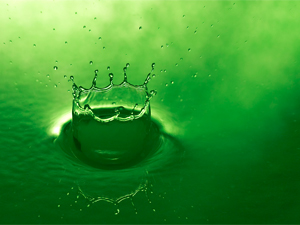10 Companies Setting Big Goals for Water Efficiency
<p>As World Water Week 2010 kicks off -- and before we report on all the new commitments and successes this year -- we present a look back at how companies are making a big splash in trimming their water footprints.</p>

It has of course been said often enough that water is the new (insert resource here), but that doesn't make it any less true, or any less important. And perhaps even more important at this point is the fact that companies large and small are making big commitments to cut their water footprints -- and achieving big successes in meeting those goals.
Over the last two years, we've reported on any number of large-scale and innovative efforts corporate leaders are making, and now that World Water Week is upon us once again, it's time to look back on some of those projects before we look ahead to the new, stepped-up goals these companies and many others will be making over the course of the week.
Below we present, in alphabetical order, some of the biggest and most impactful water commitments from the last two years.
 1. AB InBev: Throughout this list, you'll see a handful of competitors that have been pushing each other further in their water goals. It's fitting, then, to start with Anheuser-Busch InBev, which earlier this year announced its intent to become the world's greenest brewer, in part by reducing water consumption by 30 percent by 2012, relative to its 2007 baseline -- a move that the company says would make it the world's most water-efficient brewer. AB InBev is aiming to reach a 3.5 : 1 ratio of water used per liter of product, down from 4.3 : 1 in 2009. At least two of the company's breweries have already reached a 3.1 : 1 ratio already, showing how much progress is possible.
1. AB InBev: Throughout this list, you'll see a handful of competitors that have been pushing each other further in their water goals. It's fitting, then, to start with Anheuser-Busch InBev, which earlier this year announced its intent to become the world's greenest brewer, in part by reducing water consumption by 30 percent by 2012, relative to its 2007 baseline -- a move that the company says would make it the world's most water-efficient brewer. AB InBev is aiming to reach a 3.5 : 1 ratio of water used per liter of product, down from 4.3 : 1 in 2009. At least two of the company's breweries have already reached a 3.1 : 1 ratio already, showing how much progress is possible.
2. Abbott: This pharmaceutical company has put its water use to a "stress test" in order to meet a 40 percent reduction goal by 2011. The efforts have proceeded admirably: As of late 2009, Abbott had already cut its water use by 37 percent, and in the process was saving 1 billion gallons of water per year. The stress tests came by way of the WBCSD's Global Water Tool, and shows how simple projects like identifying leaks in manufacturing facilities can add up to big savings.
3. Coca-Cola: The first of another matched-set of industry rivals that are swimming neck-and-neck in water-reduction efforts, Coke in 2008 teamed up with the World Wildlife Fund to improve water efficiency 20 percent by 2012, relative to a 2004 baseline. And the company is working to improve water quality in areas of the world where it does business; for World Water Day 2010 in March, Coca-Cola added $12.7 million to its commitment to the Water and Development Alliance. Among the Coca-Cola family of companies, water efficiencies are trickling in as well: Coca-Cola Enterprises, the production and distribution arm of the soda empire, has cut the water used in production by nearly 6 percent since 2007, and plans to cut it by an additional 20 percent in the next 10 years.
4. Gap: The clothing giant has been wearing its water use on it sleeve of late -- or at least on the seat of its pants. Last year, the company began including on the product label the word about its efforts to make sure that water leaving its manufacturing facilities is at least as clean as when it entered. The company developed its guidelines in partnership with BSR's Sustainable Water Group; by the end of 2008, 71 Gap laundries had complied with the program, and the company is working with the 19 failing laundries to create corrective action plans.
5. General Electric: As part of the company's ambitious -- and highly profitable -- ecomagination initiative, GE in 2008 committed to a 20 percent reduction in water use by 2012. In 2009, we got a glimpse of how the company was going about achieving that goal when the company showed off how a data center efficiency project cut water use by 20 percent per year, reaching annual savings of 2 million gallons. Those successes led GE to up the ante earlier this year, when its 2009 sustainability report set a water reduction goal of 30 percent over its 2004 baseline.
6. IBM: It's probably not accurate to call GE and IBM industry rivals -- both companies are too large and far-reaching to compare in any meaningful way. But each firm has been applying technology to their operations as well as to their customers', and seeing big savings as a result. IBM's "Smarter Planet" initiative takes as one focus water efficiency, and by the end of 2009, IBM's microelectronics manufacturing operations had attained an average annual water savings of 3.1 percent over the past five years, more than 50 percent higher than its 2 percent goal. The company has also built a big business out of managing water use, launching two sensor-based management projects in Galway, Ireland and the San Francisco Bay.
7. Kraft: Perhaps no other company on this list highlights how quickly a concerted effort on water use can make a big impact. In 2009, we reported that Kraft had managed to cut its global water use by 21 percent in three years, handily beating its 15 percent goal and saving 3 billion gallons of water in the process. The company used a number of methods to achieve its successes, including the use of a closed-loop system to reuse water for cooling coffee grinders in its Jacksonville, Fla., coffee plant; a water-use audit in its Port Melbourne, Australia, plant that will save 20 million gallons of water per year (a 39 percent reduction); an employee education project in Champaign, Ill., to raise awareness about water conservation; and an overhaul of cleaning processes in a cheese and beverage plant in the Middle Eastern kingdom of Bahrain that reduced water use by 33 percent.
8. Pepsi: Along with Coca-Cola, PepsiCo is running neck and neck in boosting the efficiency of its water use -- after all, water is absolutely essential to its existence. During World Water Day this year, the company set a goal of becoming water-positive in water-stressed areas in which it works, as well as helping 3 million people in developing countries get access to safe water by 2015. One example of how Pepsi is working on its "positive water balance" came from India; earlier this year the CEO of PepsiCo India, Sanjeev Chadha, wrote about how building dams in India was a key part of meeting that goal. Companywide, PepsiCo aims to reduce its water consumption per unit of production worldwide by 20 percent by 2015.
9. SABMiller: Alongside AB InBev, SABMiller -- the brewer behind Miller Genuine Draft, Pilsner Urquell, and other brands -- is working hard to streamline its water use. Its 2010 Sustainable Development Report revealed that the company has reduced the amount of water it uses to make beer by 4 percent, and set a 2015 goal of reducing water use per hectoliter of beer by 25 percent between 2008 and 2015, or 3.5 hectoliters of water used for ever hectoliter of beer produced. Its MillerCoors division set September 2009 as Water Stewardship Month to engage employees on water conservation and efficiency issues. In 2009, the company took the industry-leading step of publishing a detailed water footprint assessment for its Czech and South African operations.
10. Sodexo: Last but not least, the food and facility services company in 2009 set a goal of greening its clients' operations, including a 20 percent reduction in water used on the sites that Sodexo serves. Earlier that year, Sodexo announced that it had cut water use at National Geographic's on-site cafeteria by 18 percent between 2006 and 2009. For its own operations, Sodexo had installed water recycling systems at 15 of its laundry facilities to treat wastewater for reuse, a move that cut its companywide water use by 200 million gallons, and saved some facilities as much as $200,000 a year.
Photo CC-licensed by andi.vs.zf.





